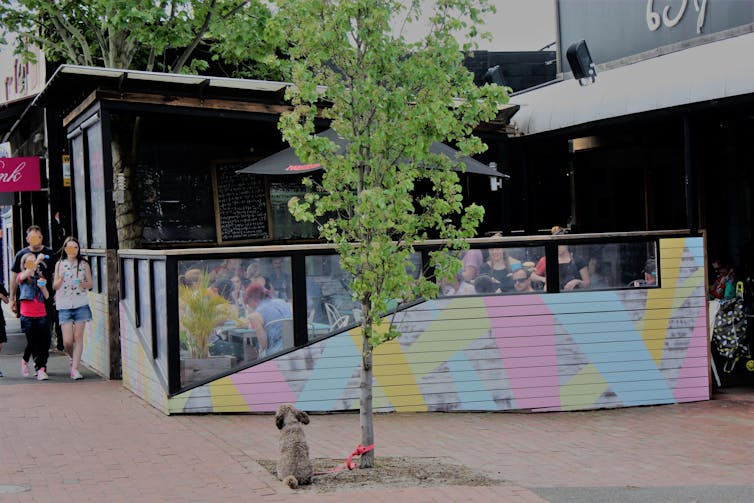This is how to create social hubs that make 20-minute neighbourhoods work
- Written by Leila Mahmoudi Farahani, Research Officer in Urban Studies, RMIT University
Successful neighbourhood centres are important as places to meet and for social activity. People’s access to neighbourhood centres and the diversity of buildings and commercial uses found there can significantly influence how, and to what extent, we interact.
Developing successful neighbourhood centres is at the core of Plan Melbourne’s strategy to create 20-minute neighbourhoods. These are neighbourhoods where people can access most of their needs within a 20-minute walk, cycle or public transport trip.
We recently studied the impacts of having diverse shops, businesses and eating places in suburban neighbourhood centres. Recently published in Urban Design International, our study looked at three such centres in Geelong, Australia.
Further reading: A 20-minute city sounds good, but becoming one is a huge challenge
Good planning can reduce suburban isolation
Often in today’s suburban communities, their only direct connection to cities is through roads and freeways. Immobile residents and people without access to private vehicles, such as teenagers and the elderly, can feel trapped in their homes. Even mobile residents can feel isolated when social interactions depend on using their cars.
Evidence suggests the design and planning of neighbourhoods have impacts on the sense of community and social life in them. Ensuring people have opportunities to interact with others, improving liveability and encouraging a sense of community are now key objectives of government agencies like VicHealth.
Neighbourhood planning and design can encourage face-to-face social interaction in various ways. Promoting diverse commercial uses in local centres is considered to be effective.
Diverse uses promote social activity
Our study mapped users’ activities through observation of how they socialised. The study explored how the arrangement and diversity of commercial uses in neighbourhood centres might better promote or affect the social life of neighbourhoods and reduce isolation. The goal of such strategies is to generate a sociable atmosphere, attract a diversity of users and create more vibrant places at night.
Pavement dining was found to play an important role in generating social activities in neighbourhood centres. Several socialising activities – such as people chatting, having a coffee or meal together – happen around cafés and restaurants. These are also the longest-lasting social interactions.
The areas of greatest social activity on pavements are the ones claimed by café chairs and shades. To encourage social activities on streets, local councils should promote the use of pavements by eateries and other traders.
Food stores and other convenience stores attract many visitors to local centres and enhance the chances of interaction among residents. Besides diversity of uses, the number of stores allocated to each group of uses is important. The right mix of stores and services provides the balance neighbourhood centres need to successfully meet local requirements.
Diversity of uses – rather than housing multiple traders in single-tenant “super” markets – can also enhance the character of a street. Diversity can give a street or a local centre an attractive, sociable atmosphere. Pakington Street, crowded with bars and restaurants, is an example of a vibrant social hub in Geelong.
 Pakington Street in Geelong.
Leila Farahani, Author provided
Pakington Street in Geelong.
Leila Farahani, Author provided
Diversity of uses also leads to a diversity of users. Co-locating different commercial uses, such as boutiques and clothing, specialty food shops or gaming parlours, can make streets more appealing to various groups of people. Planning neighbourhood centres that appeal to a diverse range of people in terms of age, gender, physical ability and cultural background can guarantee the vitality and success of local centres.
As well as planning, it’s vital that these social hubs are close to the homes of the people who use them. Suburbs can still be isolating environments if people have to get into their cars to visit their nearest social hub.
Diversity is also important in determining a street’s nightlife and evening economy. This is because certain uses are more prominent in the evening, and enhancing social activity on streets creates a safer night-time environment.
Further reading: Street life: how do you revive a dull urban area?_
More social, happier and healthier
Why should planners work to promote social interactions? The suburban lifestyle is associated with weaker social ties and increased social isolation. The lower the density the greater these associations.
Social isolation is a major risk factor for morbidity and mortality. Socially isolated people are at risk of low self-esteem and higher rates of coronary heart disease, depression and anxiety. So people living in low-density suburbs are at particularly high risk.
Feelings of isolation in low-density suburbia are harder on some residents than others. People who spend much of their time at home, such as the elderly or those with debilitating disability, are more vulnerable. The story of Natalie Wood, found in her home eight years after her death, is a sad example.
While communication technology sometimes can reduce isolation, this does not replace the value of face-to-face interactions. By analysing and understanding the diversity of uses needed for a local centre and carefully planning a balanced mix of functions, planners can help encourage these interactions and social cohesion in suburbs.
Further reading: Lonely over Christmas: a snapshot of social isolation in the suburbs
Authors: Leila Mahmoudi Farahani, Research Officer in Urban Studies, RMIT University



